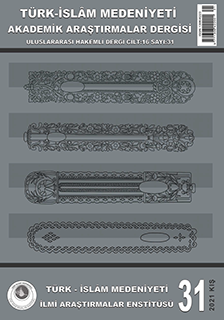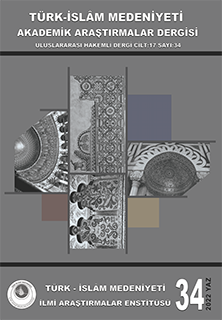Mystic and Pschological Effects of the Sense of Ecstasy
Keywords:
Ecstasy, delirium, observation, love, self-realization and selftranscending, personality ıntegrity and self-discoveryAbstract
Sufi culture establishes completeness between Allah, universe and man. Sufism is therefore the philosophy of love and completeness. Man, within the context of perfect human concept, is the greatest receptor of Allah and is a manifestation of divine names and titles. Sufism advocates that all beings, whether conscious or not, are each a reflection of the divine names and titles of Allah. A person who witnesses the reflections of the divine names and titles of Allah in universe and in beings will experience spiritual thrill, jubilation, tranquillity, divine love and inner peace. He will be overwhelmed with joy. This state of divine love, jubilation, peace and reaching the Creator is called ecstasy. True state of ecstasy is achieved by an advanced level of love towards Allah, strong will and fondness of Allah. Upon hearing his inner voice and turning towards Allah, man starts experiencing either a deep rooted relief or gloom. As a result, state of ecstasy removes man from his natural state and turns him towards forming completeness with the names and titles of Allah. Being the state of achieving the Creator through divine love, jubilation, excitement and peace, ecstasy has mystic and psychological effects. Through the state of ecstasy, man experiences delirium, observation and love. Man, at the same time, also starts bearing the traits of those who succeeded in self-realization, self-transcending, self-integrity and self-discovery.
References
Akşemseddin, (2007). Makâmatu’l-Evliyâ, İstanbul: Süleymaniye Kütüphanesi, Reşit Efendi Kitaplığı, No: 345, vrk. 181a-b.
Cebecioğlu, E. (2004). Tasavvuf Terimleri ve Deyimleri Sözlüğü. İstanbul: Anka Yayınları.
Cevziyye, İ. K. (1979). Medâricu’s-Salikîn. Beyrût: Dâru’n-Nifâs. Ergül, N. (2015). Tasavvufta Çevre Algısı. The Journal of Academic Social Science Studies, 34(2), 205-216.
Filiz, L. (2013). Noktanın Sonsuzluğu. İstanbul: Pan Kitabevi.
Gilman, L. (1985). Difference and Pathology. New York: Cornell University Press.
Güngör, E. (1982). İslam Tasavvufunun Meseleleri. İstanbul: Ötüken Yayınları.
Hakverdioğlu, M. (2012). Fuzûlî’de Âşk ve Âşık Kavramı, The Journal of Academic Social Science Studies International Journal of Social Science, 5(1), 131155.
Herring, P., O'Connor, P. (1994). The Effects of Self-Discovery. New York: American Psychiatric Association Press.
Hökelekli, H. (2011). Ailede, Okulda, Toplumda Değer Psikolojisi ve Eğitimi. İstanbul: Timaş Yayınları.
Hucvirî. A. B. O. (2006). Keşfü’l-Mahcûb, thk. Mahmûd Âbidî, Tâhran: Intişârât-ı Sâdâ ve Sîmâ.
Kelâbâzî, E. B. M. (1994). Taaruf li Mezhebi Ehli't-Tasavvuf. thk. Ahmed Şemseddin, Beyrût: Dâru'l-Kütübü'l-İlmiyye.
Kula, N. (2000). Sahip Olma ve Emanet Duyguları Açısından İnsan ve Çevre İlişkileri, Çevre ve Din. Uluslararası Çevre ve Din Sempozyumu Bildiri Metinleri, İstanbul.
Kuşeyrî, A. (1993). Risâletu’l-Kuşeyrîyye fi Ilmi’t-Tasavvuf, Beyrût: Dâru’l-Hayr.
Lauster, P. (2000). Âşk ve Aşkın Psikolojisi. (çev. Nurittin Yıldıran). Ankara: Doruk Yayıncılık.
Maslow, A. H. (2001). Maslow's Concept of self Actualization. (translate. Michael Daniels). New York: Liverpool John Moores University Press.
Mcgaughey, W. (2001). Rhythm and Self-Consciousness. Minneapolis: Thistlerose Press.
Meyerovitch, E. D. V. (2004). Duanın Ruhu. (çev. Cemal Aydın). İstanbul: Şûle Yayınları.
Nifferî, A. (1935). The Mawāqif and Mukhātabāt. nşr. Arthur J. Arberry, Messrs Luzac & Co., London.
Rûmî, M. C. (1375). Mesnevi-i Manevî, haz. R.A. Nicholson. Tahrân: Intişârât-ı Hermes. c. 3, b. 1146, 278.
Saruhan, M. S. (2013). İslam Ahlâk Esasları ve Felsefesi. Ankara: Grafiker Yayınları.
Schmahmann, J. (1997). Trandance and Cognition. New York: Academic Press.
Schroeder, L. (1997). The Science of God, New York: Free Press.
Sühreverdî, E. H. Ş. (1966). Avârifü’l-Maârif. Beyrût: Dâru’l-Kitâbi’l-Arabiyyi.
Tûsî, E. N. S. (1960). Luma fi’t-Târihi’t-Tasavvufi’l-İslamiyyi, Kâhire: Dâru’lKütübi’l-Ilmiyyeti.
Uluç, T. (2007). İbn Arabî’de Sembolizm. İstanbul: İnsan Yayınları.
Uludağ, S. (1992). İslâm Açısından Mûsikî ve Semâ. Bursa: Marifet Yayınları.
Uludağ, S. (2003). Meczup, Türkiye Diyanet Vakfı Islam Ansiklopedisi. İstanbul: Türkiye Diyanet Vakfı Yayınları, c. 1-44.
Yılmaz, H. K. (2006). Cezbe, Türkiye Diyanet Vakfı İslam Ansiklopedisi. İstanbul: Türkiye Diyanet Vakfı Yayınları, c. 1-44.
Yılmaz, H. K. (2002). Anahatlarıyla Tasavvuf ve Tarikatlar. İstanbul: Ensar Neşriyat.
Downloads
Published
How to Cite
Issue
Section
License

This work is licensed under a Creative Commons Attribution-NonCommercial 4.0 International License.







